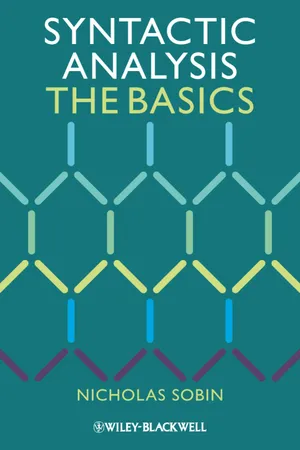
- English
- ePUB (mobile friendly)
- Available on iOS & Android
eBook - ePub
About this book
Highly readable and eminently practical, Syntactic Analysis: The Basics focuses on bringing students with little background in linguistics up to speed on how modern syntactic analysis works.
- A succinct and practical introduction to understanding sentence structure, ideal for students who need to get up to speed on key concepts in the field
- Introduces readers to the central terms and concepts in syntax
- Offers a hands-on approach to understanding and performing syntactic analysis and introduces students to linguistic argumentation
- Includes numerous problem sets, helpfully graded for difficulty, with model answers provided at critical points
- Prepares readers for more advanced work with syntactic systems and syntactic analyses
Frequently asked questions
Yes, you can cancel anytime from the Subscription tab in your account settings on the Perlego website. Your subscription will stay active until the end of your current billing period. Learn how to cancel your subscription.
At the moment all of our mobile-responsive ePub books are available to download via the app. Most of our PDFs are also available to download and we're working on making the final remaining ones downloadable now. Learn more here.
Perlego offers two plans: Essential and Complete
- Essential is ideal for learners and professionals who enjoy exploring a wide range of subjects. Access the Essential Library with 800,000+ trusted titles and best-sellers across business, personal growth, and the humanities. Includes unlimited reading time and Standard Read Aloud voice.
- Complete: Perfect for advanced learners and researchers needing full, unrestricted access. Unlock 1.4M+ books across hundreds of subjects, including academic and specialized titles. The Complete Plan also includes advanced features like Premium Read Aloud and Research Assistant.
We are an online textbook subscription service, where you can get access to an entire online library for less than the price of a single book per month. With over 1 million books across 1000+ topics, we’ve got you covered! Learn more here.
Look out for the read-aloud symbol on your next book to see if you can listen to it. The read-aloud tool reads text aloud for you, highlighting the text as it is being read. You can pause it, speed it up and slow it down. Learn more here.
Yes! You can use the Perlego app on both iOS or Android devices to read anytime, anywhere — even offline. Perfect for commutes or when you’re on the go.
Please note we cannot support devices running on iOS 13 and Android 7 or earlier. Learn more about using the app.
Please note we cannot support devices running on iOS 13 and Android 7 or earlier. Learn more about using the app.
Yes, you can access Syntactic Analysis by Nicholas Sobin in PDF and/or ePUB format, as well as other popular books in Filología & Sintaxis en lingüística. We have over one million books available in our catalogue for you to explore.
Information
Table of contents
- Cover
- Praise for Syntactic Analysis
- Title Page
- Copyright
- Acknowledgements
- Abbreviations
- Introductory Notes and References
- Chapter 1: Doing Science with Language: Introductory Concepts
- Chapter 2: The Structure and Classification of Words
- Chapter 3: Determining the Structure of Sentences
- Chapter 4: Rules of Sentence Structure: A First Approximation
- Chapter 5: Assigning Meaning in Sentences
- Chapter 6: Some Category-Neutral Processes
- Chapter 7: How Structure Affects Pronoun Reference
- Chapter 8: Complex Verb Forms
- Chapter 9: Real vs. Apparent Sentence Structure
- Chapter 10: Generalizing Syntactic Rules
- Chapter 11: Functional Categories
- Chapter 12: Questions, Relative Clauses, and WH Movement
- Chapter 13: NP Movement
- Chapter 14: Things to Come: Various Aspects of “Current Theory”
- Appendix 1: Minor Grammatical Categories
- Appendix 2: Argument Structures
- Index